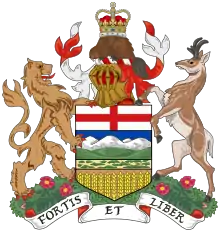9th Alberta Legislature
The 9th Alberta Legislative Assembly was in session from February 20, 1941, to July 7, 1944, with the membership of the assembly determined by the results of the 1940 Alberta general election held on March 21, 1940. The Legislature officially resumed on February 20, 1941, and continued until the fourth session was prorogued on March 24, 1944 and dissolved on July 7, 1944, prior to the 1944 Alberta general election.[1]
| 9th Alberta Legislature | |||
|---|---|---|---|
| Majority parliament | |||
| February 20, 1941 – July 7, 1944 | |||
 | |||
| Parliament leaders | |||
| Premier (cabinet) | William Aberhart (Aberhart cabinet) September 3, 1935 – May 23, 1943 | ||
| Ernest Charles Manning (Manning cabinet) May 31, 1943 – December 12, 1968 | |||
| Leader of the Opposition | James H. Walker February 22, 1941 – April 8, 1941 | ||
| Alfred Speakman January 29, 1942 – March 19, 1942 | |||
| James Mahaffy February 18, 1943 – March 30, 1943 | |||
| James H. Walker February 10, 1944 – March 24, 1944 | |||
| Party caucuses | |||
| Government | Social Credit Party | ||
| Opposition | Independent Citizen's Association | ||
| Recognized | Liberal Party | ||
| Labour Party | |||
| Legislative Assembly | |||
| Speaker of the Assembly | Peter Dawson February 25, 1937 – March 24, 1963 | ||
| Members | 57 MLA seats | ||
| Sovereign | |||
| Monarch | George VI December 11, 1936 – February 8, 1952 | ||
| Lieutenant Governor | Hon. John Campbell Bowen March 23, 1937 – February 1, 1950 | ||
| Sessions | |||
| 1st Session February 20, 1941 – April 8, 1941 | |||
| 2nd Session January 29, 1942 – March 19, 1942 | |||
| 3rd Session February 18, 1943 – March 30, 1943 | |||
| 4th Session February 10, 1944 – March 24, 1944 | |||
| |||
Alberta's 9th government was controlled by the majority Social Credit Party for the second time, led by Premier William Aberhart until his death on May 23, 1943, when he was replaced by Ernest Manning who would go on to be the longest serving Premier in Alberta history. Manning would and jettisoned the unpopular monetary policies of Aberhart during his term for more traditional conservatism. The Official Opposition was led by James H. Walker a member of the Independent Citizen's Association from February 22, 1941 to April 8, 1941, and again from February 10, 1944 to March 24, 1944. In between Alfred Speakman would serve as Opposition Leader from January 29, 1942 to March 19, 1942, and James Mahaffy from February 18, 1943 to March 30, 1943. The Speaker was Peter Dawson who would serve until his death during the 15th legislature on March 24, 1963.
An independent movement started by the Conservatives and including most Liberals and some former United Farmer supporters won 19 seats. The remaining Liberal Party that did not endorse the independent movement won one seat and a Labor man won one seat. Two independents would re-join the Liberal party and the Co-operative Commonwealth entered the Legislature in its first by-election.
Bills
During the second session the government would introduce An Act to prohibit the Sale of Lands to any Enemy Aliens and Hutterites for the Duration of the War (Bill 60) which prohibited the purchase or registration of lands by an enemy alien or Hutterite. It is the intention to prevent these people from buying land or from becoming registered as the owners of land at least until after the Second World War ended. The government would later introduce An Act to amend The Land Sales Prohibition Act (Bill 48) in the third session, which amended The Land Sales Prohibition Act for the purpose of extending this prohibition to leases and agreements for leases.[2] The federal government under Prime Minister William Lyon Mackenzie King's's Cabinet would disallow the legislation on the recommendation of the Federal Minister of Justice Louis St. Laurent. This was the last use of the federal disallowance authority in Canadian history (not to be confused is reservation authority which was last used in Saskatchewan in 1961).[3] The King government's rationale for the disallowance was the federal government had regulated all matters related to enemy aliens and the statute would conflict with federal policy.[4]
Party standings after 9th General Elections
| Affiliation | Members | |
| Social Credit | 36 | |
| Independent | 19 | |
| Liberal | 1 | |
| Labor | 1 | |
| Total |
57 | |
References
- Perry, Sandra E.; Footz, Valerie L. (2006). Massolin, Philip A. (ed.). A Higher Duty: Speakers of the Legislative Assemblies. Edmonton, AB: Legislative Assembly of Alberta. p. 496. ISBN 0-9689217-3-6. Retrieved August 9, 2020.
- "Bill 60: An Act to prohibit the Sale of Lands to any Enemy Aliens and Hutterites for the Duration of the War" (PDF). assembly.ab.ca. Legislative Assembly of Alberta. Retrieved 13 August 2020.
- Wherry, Aaron (September 12, 2013). "What can the federal government do to challenge Quebec's charter of values?". Maclean's. Ottawa. Retrieved 13 August 2020.
- Bishop, Charles (April 14, 1943). "Disallow Alberta Alien Land Act". Calgary Herald. p. 1. Retrieved August 14, 2020.
Further reading
- Normandin, A. L., ed. (1944). The Canadian Parliamentary Guide. Ottawa: Mortimer Company Ltd. ISSN 0315-6168. OCLC 893686591. Retrieved August 9, 2020.
- Office of the Chief Electoral Officer; Legislative Assembly Office (2006). A Century of Democracy: Elections of the Legislative Assembly of Alberta, 1905-2005. The Centennial Series. Edmonton, AB: Legislative Assembly of Alberta. ISBN 0-9689217-8-7. Retrieved May 25, 2020.
- Perry, Sandra E.; Footz, Valerie L. (2006). Massolin, Philip A. (ed.). A Higher Duty: Speakers of the Legislative Assemblies. Edmonton, AB: Legislative Assembly of Alberta. ISBN 0-9689217-3-6. Retrieved August 9, 2020.
